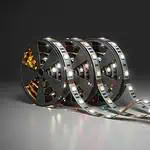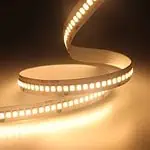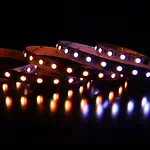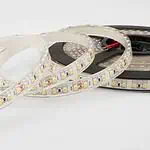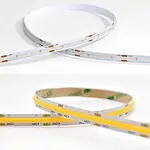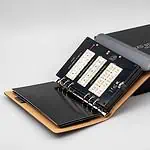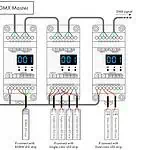While purchasing LED strips, you will find numbers like 2835, 3528, and 5050 in the specification, which may need clarification. These numbers indicate the size of the LED. But what do these numbers mean, and why are they important?
LED numbers are the four-digit numbers indicating the size of the LED. Different LED sizes are available in the market, of which 2835, 3528, and 5050 are the most common. 2835 means the chip with this numbering has a 2.8mm * 3.5mm dimension. And likewise, 3528 and 5050 indicate the chip dimension of 3.5mm * 2.8 mm and 5.0mm * 5.0mm, respectively. Besides just the sizes, these numbers also represent the different properties of the LEDs.
This article will cover LED numbers, their meaning, properties, and how they differ. So let’s explore-
Before diving in, are you new to LEDs? Here are a few resources:
LED Strip Light Production Flow.
LED Strip Light Internal Schematic and Voltage Information.
How to Wire LED Strip Lights(Diagram Included).
RGB vs. RGBW vs. RGBIC vs. RGBWW vs. RGBCCT LED Strip Lights.
35 LED Strip Ideas for the Bedroom.
What Are LED Numbers?
LED numbers indicate the size of the LED in millimeters. It is a four-digit number, of which the first two digits represent the width of the LED. And the last two digits tell you its length. These numbers are usually expressed with the initial ‘SMD,’ which means ‘Surface Mounted Device.’
For example- SMD2835 implies the width of the LED is 2.8 millimeters, and its length is 3.5 millimeters. So, the larger the number, the more prominent the LED size. LEDs can be of different sizes, among which 2835, 3528, and 5050 are the most common.
Why Are LED Numbers Important?
The lighting effect of a LED fixture, like LED strips, depends much on the size of the chips. A bigger chip provides more prominent illumination than a smaller chip. So, LED numbers are essential, as they indicate LED chip sizes.
With the LED numbers in the specifications, you can quickly determine the lighting effect of the fixture. For example- an SMD5050 LED strip has bigger LEDs than SMD2835. So, the illumination of SMD5050 is brighter than SMD2835. Thus, these numbers tell you about the LED’s brightness. Again LED numbers let you know the number of LEDs that can fit per foot of PCB. And a larger LED size means only a few chips can fit in the PCB.
These numbers further indicate the LED’s power, intensity, beam angle, and efficiency. However, these values may vary with the LED density and brands. Different brands have standardized values for specific SMD numbers. For example- a 5050SMD 120LEDs single color LED strip of LEDYi has a power of 28.8 W and a beam angle of 120 degrees. Thus, LED numbers are essential to know the chip size, brightness, and power consumption. To sum up, these numbers give you an overall idea of the lighting.
What is SMD in LED?
To understand the term ‘SMD’ better, first, let us know about the construction of the LED strips. In a LED strip, the LEDs are mounted into a thin printed circuit board, PCB, without wirings. As these LED chips are directly mounted on the board’s surface, these chips are called surface-mounted devices or SMD. That is why the term SMD is often used as synonymous with LEDs. But this is incorrect, as there are non-SMD LEDs also like- COB and MCOB.
The term SMD is used in the LEDs along with four-digit numbers to indicate the size of the LED chips. Thus, SMD 2835, SMD3528, and SMD5050 show different LED sizes. However, all these numbers have specific features that you will know in the below portion of the article.

What is SMD2835?
SMD2835 means the width of the LED is 2.8 mm, and its length is 3.5mm. These LEDs have an identical appearance to the SMD 3285 chips. The latest technology in 2835 makes it significantly more reliable and steady. These LEDs are more energy efficient and brighter in comparison to SMD 3285. For LED strips, SMD 2835 is a trendy size. Additionally, it includes high-output LEDs with a long life.
What is SMD3528?
Surface Mounted Devices, like the SMD 3528, are considerably smaller. It is 3.5mm wide and 2.8mm in length. These LEDs include one diode in each LED. Due to the smaller size of these chips, you can add more of these chips per foot of the PCB. These chips are usually used in LED strips of 60 LEDs/meter. However, LEDYi SM3528 LED strips are available in 60LEDs, 120LEDs, 180LEDs, and 240LEDs per meter. Besides, we have customization options also!
What is SMD5050?
When discussing the SMD5050, they are as popular as the SMD 3528. SMD 5050 is 5.0mm x 5.0mm in size. This refers to a tri-chip, a three-diode in one LED. And so an SMD5050 LED produces three times more light than a one-diode SMD3528 chip. And because of this, it is essentially used as “task lighting.” These types of lighting are employed in areas where you are working— a kitchen and a study room.
These chips are suitable for RGB lighting. With the three-in-one chip of SMD5050, you can make millions of hues in RGB lighting. Besides, SMD 5050 is ideal for general lighting, such as replacing bright fluorescent lighting in homes, bars, restaurants, hotels, and other institutions.

What Is The Difference Between 2835, 3528, And 5050 LED Strips?
Besides the chip sizes, the LED numbers 2835, 3528, and 5050 have many other differences. Check the table below to know them-
| Factors | SMD2835 | SMD3528 | SMD5050 |
| LED Size | 2.8mm * 3.5mm | 3.5mm * 2.8mm | 5.0mm * 5.0mm |
| Type of Chip | single-chip | single-chip | tri-chip |
| Brightness | High | Medium | Highest |
| Light emitting surface | Rectangular | Circular | Circular |
| Heat dispersion rate | Less | More | More |
| Price | Medium | Cheap | Pricey |
So, comparing all these three LED numbers, we can find SMD2835 is the smallest chip. It has better heat dispersion than the other two. Again, for brightness, SMD5050 is the best option. However, for an affordable range, SMD3528 stands out.

SMD2835 Vs. SMD3528- Which One Is Better?
SMD2835 and SMD3528 are quite popular sizes of LED chips. To find out the better one of these two, first, let us know the differences between them-
| Criteria | SMD2835 | SMD3528 |
| LED Size | 2.8mm * 3.5mm | 3.5mm * 2.8mm |
| Technology | Latest | Old |
| Brightness | Higher | Lower |
| Light emitting surface | Rectangular with round edges | Circular |
| Heat dispersion | Better | Regular |
| Price | Expensive than SMD3528 | Affordable |
From the above chart, you have already guessed SMD2835 is a better version of SMD3528. Let me explain the reasons-
- SMD2835 has the latest technology, whereas SMD3528 is a first-generation LED chip. The advanced technology available in SMD2835 solves the point light source phenomenon in 3528 lighting applications.
- The light-emitting surface of SMD2835 is rectangular with round corners. On the other hand, SMD3528 has a circular light-emitting surface. Comparing their surface area, SMD2835 has 2.1 times more light-emitting areas than SMD3528. Thus, it produces more uniform and bright lighting.
- SMD2835 excels for its lower heat dispersion. Due to its thin dimension and more extensive cooling area, it produces much less heat than SMD3528.
- SMD2835 has more efficiency. It produces equivalent brightness using less energy in comparison to SMD3528.
So, considering all these factors, SMD2835 is better than SMD3528.
SMD3528 Vs. SMD5050- Which One Is Better?
SMD3528 and SMD5050 both have circular light-emitting surfaces. Except for the sizes, they look almost the same in physical appearance. But there are differences in their lighting capability. Let’s check their differences before deciding which one is best.

| Criteria | SMD3528 | SMD5050 |
| LED Size | 3.5mm * 2.8mm | 5.0mm * 5.0mm |
| Chip Type | Single-chip | Tri-chip |
| Brightness | Lower | Higher |
| Color option | Single color | Versatile color |
| RGB Application | No | Yes |
| No. of chip/foot | More than SMD5050 | Limited due to large chip size |
| Price | Cost-effective | Expensive |
This chart may confuse you to get the better one as both SMDs have some plus points. No worries, check the size-wise comparison between SM5050 and SMD 3528 to choose the ideal one for you-
- The size of SMD3528 is 3.5mm * 2.8mm. In contrast, SMD5050 has a dimension of 5.0mm * 5.0mm. So, the light-emitting surface of SMD5050 is much higher than SMD3528.
- In terms of brightness, SMD5050 produces three times greater illumination than SMD3528. Thus, it is more suitable for ambient and task lighting.
- SMD3528 is a single-diode chip. In comparison, SMD5050 is a three-in-one chip. That is, it can have three different diodes in a single chip. Thus, it gives excellent brightness and open options for multi-color lighting.
- RGB lighting is structured using SMD5050 chips. It easily fits the red, green, and blue diode in its three-in-one chip. Thus, with the SMD5050 chip, you can produce millions of hues. But, SMD3528 is suitable only for monochromatic lighting. In contrast, SMD5050 can have both monochromatic and RGB lighting.
So, considering these factors, SMD5050 offers higher brightness and better lighting options. But only a few SMD5050 can fit per foot of PCB due to larger chip sizes. Thus, it creates a brightness restriction for SMD5050. On the other hand, more SMD3528 can fit in PCB/foot. Besides, SMD3528 is also cost-effective. So, if you want high density single color lighting, SMD3528 is an ideal choice.

What Are Other Numbers Used in LED Strip Lights?
Besides the most common LED numbers, 2835,3528, and 5050, many other chip sizes are available for LED strips. These are-
- SMD1808: With a size of just 1.8*0.8mm, SMD 1808 is among the most minor LEDs.
- SMD2010: An alternative to the SMD1808 is the SMD2010, which has a dimension of just 2.0*1.0mm.
- SMD3014: The dimension of the LED is 3.0mm * 1.4mm. The SMD3014 strips of LEDYi are available in two variants, front-emitting and side-emitting.
- SMD2216: They have a dimension of 2.2mm * 1.6 mm. Due to the smaller lamp size, these SMD2216 LED strips can be narrower, and the LED density can be denser.
- SMD2110: It has a dimension of 2.1mm * 1.0mm. SMD2110 is an upgraded version of the SMD2216 with a thicker bead holder that makes it robust.
- SMD5630: SMD5630 are the brightest LED strips with a dimension of 5.6mm * 3.0mm.
Do Bigger LED Chips Use More Electricity?
The chip size is related to electricity consumption, but the idea that bigger LED chips use more electricity is partly true. It highly depends on the technology rather than just the chip sizes. Let me explain the concept with an example of our LEDYi 60 LEDs LED strips for different SMDs:
| LED numbers | Current (A/m) | Power(W/m) |
| SMD5050 | 1.2A(12V) / 0.6A(24V) | 14.4W |
| SMD3528 | 0.4A(12V) / 0.2A(24V) | 4.8W |
| SMD2835 | 1A/0.5A | 12W |
As you can see, SMD5050 uses more electricity, which is ok as it has a larger chip size. But between SMD2835 and SMD3528, SMD2835 is the smallest in size. So, it is supposed to consume less electricity. But in reality, 2835 produces more brightness, so it uses more electricity than 3528.
Higher Density vs. Bigger LED Chips: What Is Better?
We discussed size throughout the article, but you might wonder if density is essential. The term “density” might confuse you, but it simply refers to the number of LED chips on the strip per meter.
Density = Number of Chips * Meter
Now, bigger LED chips give a brighter light. But with bigger chips, you can fit only a few SMDs per meter of your LED strip. But how are dense LED chips better?
When you have a denser LED chip, it will provide brighter and more uniform lighting. For example- about 120 LED chips as small as SMD2835 can easily fit in a one-meter strip. Thus, it gives much brighter illumination- up to 2,600 lumens per meter! It will further provide more uniformity than less dense lighting. In contrast, you can fit 30 to 60 LEDs in one meter SMD5050.
However, it doesn’t mean you must choose highly dense LED strips for uniformity. Bigger chips can also bring uniformity, for this cove lighting works best.

FAQs
The four-digit number of the LED strip indicates the width and length of each LED chip in the strip. The first two digits indicate the width of the chip, and the latter digit represents its length in millimeters. For example- SMD2835 means the chip has a 2.8mm * 3.5 mm dimension.
SMD5630 is the best choice when it comes to brightness. However, SMD5050 is another good option for better illumination. But regarding energy efficiency and advanced technology, SMD2835 stands out. Again, for affordability, SMD3528 is a good option.
SMD LEDs are more energy efficient than COB LEDs. Besides, it doesn’t require larger heat sinks than COB LEDs. Again when it comes to versatility, SMD has color temperature-changing options. But COB produces only one color temperature. Considering these factors, SMD stands over COB. However, COB lighting also has its features. It makes better light uniformity and gives a seamless effect.
SMD5050 is a three-in-one chip. So, it can put three different diodes in a single chip. These features make it ideal for RGB lighting. Compared to SMD3528, SMD5050 emits three times brighter light.
The 5630 LEDs are, without a doubt, the brightest. The dimensions of this chip are 5.6mm * 3.0mm. Because of its brighter illumination-producing capability, SMD5630 is an excellent choice for commercial lighting.
Yes, SMD 2835 is more energy efficient than the other SMDs. An SMD 2835 produces 20% more light compared to SMD5050, using less energy. Based on 60 LEDs per meter, each 2835 SMD consumes 0.2 watts (compared to 0.24 watts for 5050 SMDs), or about 12 watts per meter, as opposed to 14.4 watts for the 5050 SMD.
Here are a few examples of SMD5050 applications:
- Lighting for coves
- architectural lights for canopies, passageways, windows, and arches
- Signage backlit or edge lighting
- Do-it-yourself home lighting
- Marking contours and paths

End Quote
From the above discussion, you know all about different LED numbers. To sum up, LED numbers are the sizes of LEDs used in LED strips. Among the numbers 2835,3528, and 5050, 2835 is the minor LED, and 5050 is the largest. These numbers are essential features of LED strips indicating different lighting effects.
However, if you are looking for LED strips, contact LEDYi. Our LED strips are available in various sizes, densities, and power consumption ratings. Besides, we offer you customization options too.
